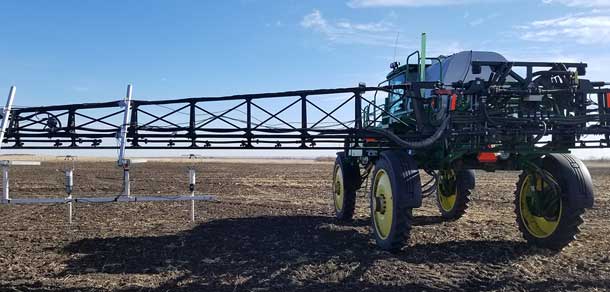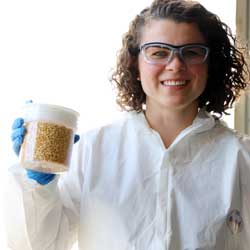
Hundreds of tonnes of pulses travel through an assembly line before they reach the bagging stage. PAMI engineers designed custom-made conveyors to allow the pulses to move down the line.
“In order to get to a consumer market, someone has to scale it up.”
Amie Harrison, Engineer-in-Training
Pulse crops are a multi-billion-dollar industry in Saskatchewan and a team at Prairie Agricultural Machinery Institute (PAMI) recently helped design a process that may add more dollars to this province’s economy by means of its top export.
More than 25 engineers of various backgrounds, technologists and technicians at PAMI adopted a food process scale-up production project as their baby. After two years of engineering and testing, close to 7,000 labour hours and a few sleepless nights the team finally achieved success.
Amie Harrison, Engineer-In-Training and various colleagues at PAMI worked with a client (for confidentiality reasons will remain anonymous) to help amplify an original process idea for pulses into a full-scale commercial process.
The client knew they wanted to extract protein from the pulses but didn’t have the steps needed to get from the raw product to the final product. Thus, they sought PAMI’s engineering expertise to help get them to a point where they could get to work in their own building with what PAMI designed.
This project was completed in PAMI’s Crop Processing Development Centre (CPDC), a flexible and configurable space that can be used to support primary processing of crops and by-products.
“We were the one-stop shop for this whole project,” said Harrison, a chemical Engineer-in-Training who served as the project manager for this undertaking.
“From the engineering design, to the fabrication of equipment, to the actual operation of the test plant. We applied all of the necessary resources to execute the project within the given scope, budget and schedule, getting the client to where they wanted to be.”
And where they wanted to be was a major leap from the original starting point. The client first presented a small Ziploc bag of the raw commodity to the team at PAMI and indicated they wanted one metric tonne per hour to be processed.
“You could imagine what we were up against,” explained David Yee, vice-president of Saskatchewan operations at PAMI.
“Someone hands you a small bag and tells you they want a metric tonne per hour processed. And they want those physical characteristics with these particular features and this level of moisture content and so on. This was a huge engineering endeavour.”
“In order to get to a consumer market, someone has to scale it up.”
Delivering pulses to market is big business in western Canada. Saskatchewan is the largest exporter of chickpeas and lentils and a significant producer of beans and dried peas. In recent years, agri-value companies have stepped in to make significant investments into further processing these crops.
Which translates into job opportunities. This project supported the Government of Saskatchewan’s value-added strategy target of increasing revenue from $3.5 billion in 2012 to $6 billion in 2020.
“One thing I found with this project was how challenging it is right now in western Canada to find highly qualified people, especially in the engineering discipline, to help support process engineering in the food and agri-food sector. More importantly, how valuable they are to the overall process of creating a food ingredient,” Yee said.
“Engineering plays a significant role and that role is about making a business proposition and a business plan actually work. In food ingredient processing, process flow and cost-per-tonne is a huge part of the solution.”
Transforming a raw pulse into an intermediate product that could eventually be used for commercial purposes was the goal for the PAMI team of engineers and technologists.
They started with bench-scale testing in a lab. Once they had proven the concept of taking their raw product (pulses) to the intermediate product they were looking for, it was time to design the equipment specific to this project.
The first days of the project saw the team experimenting with crude methods and equipment like microwaves and rolling pins in the lab to gain a better understanding of the type of commodity they were working with and what its characteristics entailed.
“At one point in working with this product, you could walk into the processing facility and it was as if it was snowing on you. That was all of your pulse dust, your product turning into dust … you’re losing money,” Yee explained.
“When we were finally done with the process you could walk in and go to a wedding afterward. You wouldn’t have one flake of dust in your hair. We were able to preserve all of the product.”
Eventually, a pilot plant was designed to test the process more completely. The pilot plant was still very manual and required manual labour to process the pulses into the intermediate product.
The next part of the project involved the design and fabrication of process equipment to be incorporated with the previously verified process equipment. Custom-made conveyors were designed and needed food-grade belting. Angles needed to be adjusted so the pulses would travel correctly. Cleats were added to help the pulses climb.
Once this equipment had been developed, a new process was created that was able to manage commercial scale with minimal labour.
“Food ingredient processing isn’t done by hand. It’s done by machinery. If you don’t have machinery support then most often, you don’t have a business plan that will work in the marketplace,” Yee said.
“If you think you can just go out and buy food processing machines from wherever and you think you can just plug them in and have the whole system work perfectly then you’d be deluded in that concept. The machines do not integrate. It’s the humans who do that integration. The integration we did within this project involved multiple machines that had to connect and deliver process flow. We had to look at bottlenecks and feed grades, things that could deliver the types of properties they wanted in their food ingredients and deliver it fast enough and at a quantity large enough so they could meet their business plan.”
Once the equipment was verified, the team was ready to jump to a commercial scale process that was less manual and more automated. One-metric-tonne bags were emptied into the process using a forklift. An optimized bagging system was used to fill the mini bulk bags at the end of the process.
The PAMI team worked a few campaigns with the client and never ceased operation during a two-week stretch that had machines running around the clock.
“It was a continuous and optimized process,” Harrison said. “You could see the inlet and you could see the outlet. You could watch these pulses travel through the process from the start line to the finish.”
One of the main goals was to reduce the cost per tonne while they were processing. The way to do that was to automate the process as much as possible. So, eventually conveyors moved the pulses instead of people.
“You want to be as efficient as possible and that means not shutting down the process unless absolutely necessary and dealing with obstacles as efficiently as possible when they come your way,” Harrison said. “There were quite a few sleepless nights where we were trying to solve a problem before the next work day, so as soon as the suppliers opened at 8 a.m., we could make the right call and get things moving.”
Harrison estimated the team processed hundreds of tonnes of pulses that were delivered to the PAMI facility via semitrailers.
Nearly two years later, the process was successfully completed. A project of this scale is rare, though it presented several learning moments for the team for future purposes.
“We went from a loosely defined idea and we turned it into something (the client) could really make money with,” Harrison explained. “A project like this involved so many elements – from fabricating parts, working with the pulses, meeting all of the food grade requirements – and so to complete all of these different aspects in one building with one team was very satisfying.”
One takeaway for Yee was the employment opportunity when it comes to similar projects.
“There is a huge role for process engineering beyond the original equipment manufacturer machinery,” he said. “What we’re finding out in the food ingredient world is that process optimization is probably one of the big values that makes the food ingredient business run. The margins are so tight that quality process engineers who really understand their craft are highly valued. The people with these skills and this knowledge will become more important as the agri-value ecosystem grows.”
